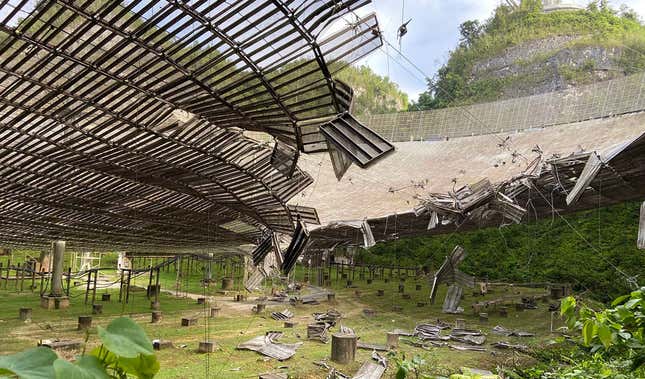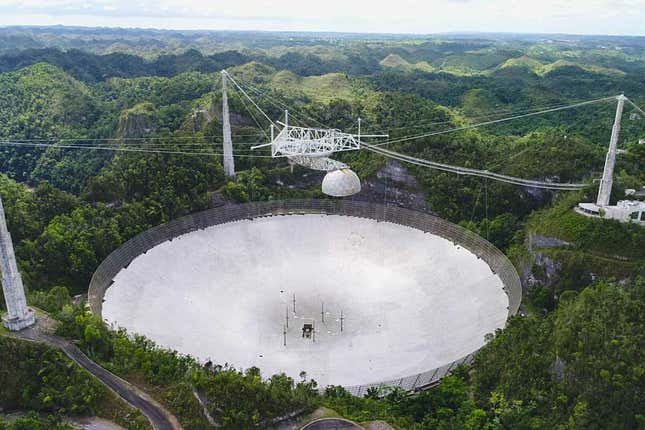
The 1,000-foot radio dish at the Arecibo Observatory in Puerto Rico has collapsed, according to officials and local reports.
Meteorologist Deborah Martorell tweeted an image of the site this morning that appears to show the 900-ton platform no longer suspended above the 57-year-old dish, suggesting it had fallen. The platform was in a precarious situation since this summer, when one of the cables supporting it failed.
The big radio dish at the Arecibo Observatory—the second largest in the world—was recently slated for demolition after engineers determined it could not be safely repaired after a second cable failure. The Associated Press is reporting this morning that the dish has collapsed, but details are scarce. The platform had been suspended 450 feet (137 meters) above the telescope dish.

In a tweet, the U.S. National Science Foundation said it was “saddened by this development,” and that the agency will be “looking for ways to assist the scientific community and maintain our strong relationship with the people of Puerto Rico.”
The instrument platform fell today at around 7:55 a.m. Puerto Rico time, according to an NSF statement. An investigation is currently underway, but the preliminary findings are not encouraging. It appears that the top section of all three towers snapped off during the collapse, and the telescope’s support cables also fell. The initial report from the NSF is that “the observatory’s learning center sustained significant damage from falling cables.” Top priorities right now are to ensure safety at the site, quickly assess the damage, and take action to “contain and mitigate any environmental damage caused by the structure or its materials,” according to the NSF.
Looking at Martorell’s photo, it appears that while the large platform has collapsed, the three support towers are still standing. This is a relief, as it was feared that another cable failure would would bring the towers down, too. Other buildings at the Arecibo Observatory, such as the LIDAR facility and the visitor’s center, were at risk of being damaged by the falling towers. The observatory draws around 90,000 visitors each year.

The decision to forgo repairs and demolish the big dish now appears to have been the sensible choice. Engineering firms brought in to assess the condition of the facility said the structure was at imminent risk of “catastrophic” failure, and that it couldn’t be repaired without placing construction workers in harm’s way, according to the NSF. The area around the dish was off-limits, so hopefully no one was in the area when the platform fell. On that note, the NSF tweeted out that no injuries were reported.
Problems at the facility started in August when an auxiliary cable slipped from its socket, creating a large gash in the dish. Then, last month, a main cable snapped. With those cables gone, the overall stability of the structure seemed to be in jeopardy. The National Science Foundation, on the advice of the independent engineering firms, then made the tough decision to decommission the big dish.
The loss of this radio dish is devastating news for the science community, as the facility has greatly contributed to our understanding of planetary bodies, near-Earth objects, extrasolar planets, gravitational waves, and pulsars. The Arecibo dish was also used in the search for extraterrestrial intelligence and featured in the 1997 film Contact. Around 250 scientists from around the world were using the observatory when it was shuttered this past August.
Despite this setback, work at the Arecibo Observatory should be able to continue eventually, though not with the main dish, obviously. The LIDAR facility, for example, will still be able to scan the upper atmosphere and ionosphere, assuming it wasn’t damaged in today’s collapse.